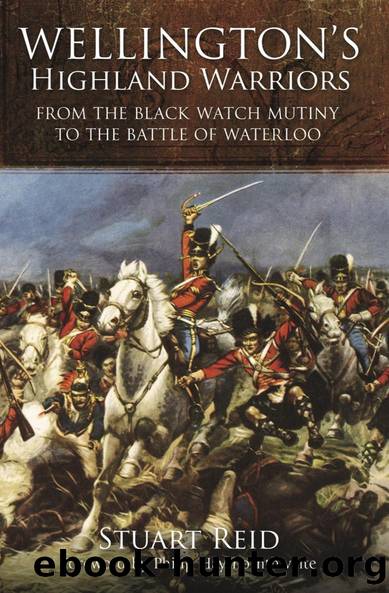Wellington's Highland Warriors by Stuart Reid

Author:Stuart Reid [Reid, Stuart]
Language: eng
Format: epub
Tags: History, Europe, Great Britain, General, Military, Wars & Conflicts (Other), Modern, 19th Century
ISBN: 9781848325579
Google: fAm6PwAACAAJ
Publisher: Frontline Books
Published: 2010-01-15T00:34:52+00:00
6
Castlebar Races: The Fencibles at War
Altyreâs efforts to bring the Strathspeys around were ultimately to be in vain, for although he soon convinced himself that everyone except the McDonnells was now willing to serve in England after all, the battalion itself was regarded by the authorities as quite unreliable and no longer wanted there. Consequently it spent the rest of its unhappy existence in Scotland, confirming officialdomâs poor opinion by briefly mutinying for a second time at Dumfries in the following year.99 Despite offering to go to Ireland, it was disbanded together with all the other first generation battalions in 1799.
In the meantime, having learned its lesson, the Government proceeded instead to raise an entirely new generation of fencible regiments, this time extending the scheme to both England and Ireland and abandoning the original restrictions on their deployment â by first widening their terms of service to include anywhere within the British Isles and the Channel Islands, and eventually to Gibraltar and the Mediterranean garrisons as well. Thus, between 1794 and 1799 some fifty new fencible battalions were raised, of which around twenty were Highland units in name at least.
This continuing heavy preponderance of Highland units was still in part a reflection of the fact that Scotland had as yet no statutory militia force to serve as a second line behind the regulars, but there was also another explanation. Encouraged by the apparent success of the original âchieftainsâ, the Government resolved to see if the others could also raise their clansmen as of old and so letters of service were freely offered to those Highland proprietors understood to retain some of their traditional influence, no matter whether they were actually fit to be entrusted with a regiment. Thus it was intimated, for example, that the Government anticipated a regiment might perhaps be raised by the Mackay gentry in âLord Reayâs countryâ â despite the fact that Lord Reay himself was generally considered quite mad. Similarly, of course, young Glengarry, who although comparatively sane was equally unfit to command anything at all, was another who got himself a regiment, as eventually did his rival, Locheil, with the Lochaber Fencibles in 1799. Breadalbane, not content with two battalions (and his regular 116th Regiment) raised a third fencible battalion; Hayâs brother, James Leith, raised the Aberdeen (Princess of Wales) Fencibles, while two entirely new regiments were raised in Argyle and a third in Dumbarton. A Caithness Legion was recruited to rival Sir John Sinclairâs Rothesay and Caithness Fencibles, which itself gained a second battalion, and there were Loyal Inverness Fencibles, Banffshire Fencibles, Fraser Fencibles, McLeod Fencibles and Elgin Fencibles; a Regiment of the Isles, the dashingly titled Ross and Cromarty Rangers, and several others besides, all of them bravely dressed in either kilt or tartan trews, and feathered bonnets.
It is very easy to be cynical about these new clan regiments and the readiness with which so many Highland proprietors and other gentlemen ânearly relatedâ to them took up commissions as fencible officers, but
Download
This site does not store any files on its server. We only index and link to content provided by other sites. Please contact the content providers to delete copyright contents if any and email us, we'll remove relevant links or contents immediately.
The Radium Girls by Kate Moore(11921)
100 Deadly Skills by Clint Emerson(4840)
Rise and Kill First by Ronen Bergman(4701)
The Templars by Dan Jones(4627)
The Doomsday Machine by Daniel Ellsberg(4415)
The Rape of Nanking by Iris Chang(4136)
Killing England by Bill O'Reilly(3951)
Hitler in Los Angeles by Steven J. Ross(3900)
Stalin by Stephen Kotkin(3875)
12 Strong by Doug Stanton(3508)
Hitler's Monsters by Eric Kurlander(3268)
Blood and Sand by Alex Von Tunzelmann(3138)
The Code Book by Simon Singh(3073)
Darkest Hour by Anthony McCarten(3070)
The Art of War Visualized by Jessica Hagy(2943)
Hitler's Flying Saucers: A Guide to German Flying Discs of the Second World War by Stevens Henry(2714)
Babylon's Ark by Lawrence Anthony(2620)
The Second World Wars by Victor Davis Hanson(2480)
Tobruk by Peter Fitzsimons(2442)
